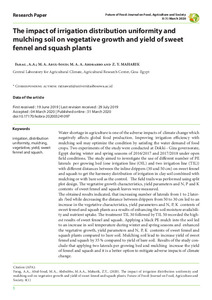| dc.date.accessioned | 2020-04-28T14:56:20Z | |
| dc.date.available | 2020-04-28T14:56:20Z | |
| dc.date.issued | 2020-03-31 | |
| dc.identifier | doi:10.17170/kobra-202003241097 | |
| dc.identifier.uri | http://hdl.handle.net/123456789/11529 | |
| dc.language.iso | eng | eng |
| dc.publisher | Section Specialized Partnerships in Sustainable Food Systems and Food Sovereignty at the University of Kassel, Germany and Federation of German Scientists (VDW) | |
| dc.rights | Urheberrechtlich geschützt | |
| dc.rights.uri | https://rightsstatements.org/page/InC/1.0/ | |
| dc.subject | irrigation | eng |
| dc.subject | distribution uniformity | eng |
| dc.subject | mulching | eng |
| dc.subject | vegetative | eng |
| dc.subject | yield | eng |
| dc.subject | sweet fennel and squash | eng |
| dc.subject.ddc | 630 | |
| dc.title | The impact of irrigation distribution uniformity and mulching soil on vegetative growth and yield of sweet fennel and squash plants | eng |
| dc.type | Aufsatz | |
| dcterms.abstract | Water shortage under climate change impacts performed the driving forces to enhance the agricultural practices to maximize the food production. Improve the distribution of irrigation water with mulching soil to satisfy the plants needs and provide optimum conditions for production consider the main objective of the current study. Two experiments of the study were conducted out at Central Laboratory for Agriculture Climate (CLAC), Agriculture Research Center, Egypt during winter and spring seasons of 2016/2017 and 2017/2018 under open field conditions. The study objected to investigating the use of different numbers of PE lateral per growing bed (1 (OIL) and 2 (TIL)) with different distance between the inline drippers (30 and 50 cm) on sweet fennel and squash to get the harmony distribution of irrigation in clay soil combined with mulching or bare soil (control). The trails of the current study presented in split plot design. The vegetative growth characteristics, yield parameters and N, P and K (%) contents of sweet fennel and squash leaves were measured.
The obtained results indicated that increasing no. of laterals from 1 to 2 laterals /bed while decrease the distance between drippers from 50 to 30 cm led to increase the vegetative characteristics, yield parameters and N, P, K (%) contents of sweet fennel and squash plants as a results of enhancing the soil moisture availability and nutrients uptake. The treatment TIL combined with 30 cm distance between emitters recorded the highest results of sweet fennel and squash followed by TIL combined by 50 cm distance between emitters. Applying black soil mulch led to increase the soil temperature during winter and spring seasons and also enhance the vegetative characteristics, yield parameters as well as N, P, K (%) contents of sweet fennel and squash plants compared to bare soil. Mulching soil led to increase the yield of sweet fennel and squash 35 % more than bare soil. Include applying two laterals per growing bed and black mulch within the agriculture practices to increase the yield of vegetable crops had a general benefits on food security and mitigation climate change impacts. | eng |
| dcterms.accessRights | open access | |
| dcterms.creator | Farag, Ahmed Awny | |
| dcterms.creator | Abul-Soud, Mohamed A. | |
| dcterms.creator | Abdrabbo, Mohamed Ahmed A. | |
| dcterms.creator | Maharik, Z. Y. | |
| dc.subject.swd | Bewässerung | ger |
| dc.subject.swd | Mulchen | ger |
| dc.subject.swd | Fenchel | ger |
| dc.subject.swd | Kürbis | ger |
| dc.type.version | publishedVersion | |
| dcterms.source.identifier | ISSN 2197-411X | |
| dcterms.source.issue | No. 1 | |
| dcterms.source.journal | Future of Food: Journal on Food, Agriculture & Society | eng |
| dcterms.source.volume | Volume 8 | |
| kup.iskup | false | |

